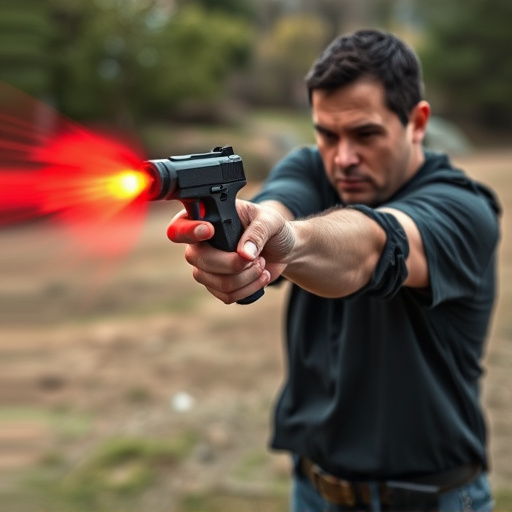Pepper spray, a powerful personal defense tool that temporarily disables attackers through capsaicin irritants, requires strategic deployment techniques like "Spray and Move" for maximum effectiveness. This method involves swift spraying aimed at the face and eyes, followed by a quick retreat to disrupt the attacker without causing permanent harm. Comprehensive training, including simulated scenarios and regular practice, is crucial for safe and responsible pepper spray use, emphasizing its role as a last resort in personal defense strategies while navigating legal and ethical considerations globally.
“Discover the power of pepper spray as a personal defense mechanism with our comprehensive guide. From understanding its basic concept and impact to exploring key components of an effective deterrent system, we demystify this self-defense tool. Learn about strategic Spray and Move Deployment Techniques for tactical advantages. We also cover training, legal considerations, and ethical use, ensuring you’re prepared and protected. Equip yourself with knowledge in the art of defending with pepper spray.”
- Understanding Pepper Spray: The Basic Concept and Its Impact
- Key Components of an Effective Pepper Spray Deterrent System
- Spray and Move Deployment Techniques: A Tactical Approach
- Training and Preparation: Ensuring Users Are Ready and Safe
- Legal Considerations and Ethical Use in Self-Defense
Understanding Pepper Spray: The Basic Concept and Its Impact
Pepper spray, a powerful deterrent, has become an essential tool for personal defense. Its basic concept revolves around the deployment of capsaicin, a chemical compound derived from chili peppers. When sprayed, it irritates the eyes, nose, and respiratory system, temporarily disabling an assailant. This impact allows the user to create distance and escape potentially harmful situations.
Effective spray and move deployment techniques are crucial in maximizing its effectiveness. Users should aim for the face and eyes, ensuring a direct hit to disrupt the attacker’s vision and breathing. After spraying, a swift retreat is vital to avoid counterattacks. The range and duration of pepper spray vary, so understanding these factors enables individuals to assess their safety and make informed decisions during potential confrontations.
Key Components of an Effective Pepper Spray Deterrent System
An effective pepper spray deterrent system is multifaceted, incorporating both technological advancements and strategic deployment techniques. Key components include a reliable and easily accessible spray device, such as a compact, non-lethal pepper spray gun or aerosol can. The method of deployment, often referred to as “Spray and Move,” is crucial. This involves a swift, controlled release of the spray followed by immediate retreat or pursuit, aiming to disrupt an assailant’s attack pattern without causing permanent harm.
Additional considerations involve environment-specific tailoring: choosing the right type of pepper spray for different scenarios (e.g., indoor vs. outdoor), integrating the system into existing security measures through automated triggers or alarm systems, and ensuring proper training for all personnel involved to maximize its effectiveness in deterring and neutralizing potential threats.
Spray and Move Deployment Techniques: A Tactical Approach
The effectiveness of pepper spray as a deterrent depends heavily on the correct deployment technique, known as the “Spray and Move” method. This tactic involves quickly applying the spray while maintaining a safe distance from the assailant, allowing the individual to retreat or disable their attacker before sustained exposure occurs. It’s not about facing off against the opponent; instead, it’s a strategic withdrawal, creating space for further action or assistance.
Training in Spray and Move Deployment Techniques is crucial for maximizing the safety of individuals who carry pepper spray. This involves practicing rapid, aimed spraying while maintaining awareness of the assailant’s position to ensure they are properly covered without risking direct contact. Such training enables users to respond calmly under pressure, making this tactic a powerful tool in personal defense strategies.
Training and Preparation: Ensuring Users Are Ready and Safe
Training and preparation are paramount in ensuring that individuals equipped with pepper spray understand its proper use as a deterrent and defense mechanism. It involves teaching users effective Spray and Move deployment techniques, which emphasize timing and distance. By practicing simulated scenarios, individuals learn to assess threats swiftly, activate the spray accurately, and then move away from the assailant, creating a safe distance.
This training also covers safety protocols, including post-incident debriefings, where users reflect on their actions and the effectiveness of the spray. Regular exercises help maintain proficiency, ensuring that individuals are ready to respond confidently in real-life situations. Moreover, proper training enables users to make informed decisions, enhancing their overall safety and security.
Legal Considerations and Ethical Use in Self-Defense
When considering pepper spray as a self-defense mechanism, it’s crucial to navigate a landscape where legal considerations and ethical use intertwine. The application of pepper spray for self-protection is governed by varying laws worldwide, with some jurisdictions allowing its use only in specific situations, such as when an individual is attacked or feels threatened. Unlawful or inappropriate deployment can lead to serious legal repercussions, including charges of assault or battery.
The ethical dimension comes into play when examining the “spray and move” deployment techniques. While these methods are designed to minimize harm and allow for quick escape, they must be employed responsibly. Ethical considerations encourage individuals to only use pepper spray as a last resort, after exhausting other peaceful means of defusing a potentially dangerous situation. The impact on bystanders, the vulnerable, or even animals should also be carefully contemplated, underscoring the need for training and awareness in using this deterrent effectively and ethically.
In conclusion, pepper spray deterrents offer a powerful yet non-lethal self-defense mechanism when used appropriately. By understanding the basic concept, key components, and deployment techniques like the proven “Spray and Move” approach, individuals can enhance their safety and security. Proper training, preparation, and legal awareness ensure its effective and ethical use in defending against potential threats.
